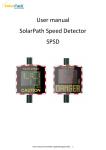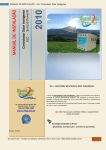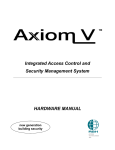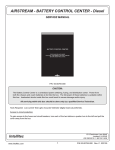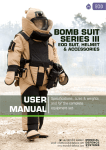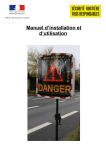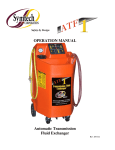Download Hunter PH20-30A User's Manual
Transcript
! " #$ ! " %%%&' Propane Heater 20,000 BTU/HR Model PH20-30A With Automatic Gas Ignition Control Installation Operation Service EXHAUST GASES Do not operate heater in an enclosed area unless the exhaust gases are piped outside. Exhaust gases may contain carbon monoxide, a colorless and poisonous gas. FUEL USE This heater is designed for use with propane (LP gas) only. Do not attempt to use gasoline as fuel since fire or explosions may result. Use this heater only with gas regulator part number 88301-T supplied with the heater. Operation with other regulators voids all warranties and may result in fire, explosion, or damage to the heater. ELECTRICAL Heater must be grounded through ground screw supplied. Do not use the fuel line as an electrical conductor or ground connections. Use of the fuel line as electrical or ground conductor may result in fire or explosion. Before performing maintenance or inspection (except operating tests), disconnect the power source. Do not operate the heater with the covers off. The tilt switch is a safety device that stops heater operation in case the vehicle overturns. Do not remove this switch or defeat its purpose. Do not operate the heater at less than 11volts. Propane flow to the burner head is constant, but blower motor speed and combustion airflow vary directly with voltage. Operation on low voltage will produce poor burning, smoke, and unburned fuel mixtures. Section One____________________________________________________________ 3 Introduction and Description __________________________________________________ 3 Description _______________________________________________________________________ 3 Section Two ___________________________________________________________ 4 INSTALLATION INSTRUCTIONS ____________________________________________ 4 Pre-Installation Inspection____________________________________________________________ 4 Location and Mounting ______________________________________________________________ 4 Electrical Requirements (FIG.1) _______________________________________________________ 6 Fuel Requirements (FIG.2) ___________________________________________________________ 6 Exhaust and Combustion Air Requirements (FIG.3)________________________________________ 7 Heater Mounting Dimensions (FIG.6)___________________________________________________ 8 Fuel Connections ___________________________________________________________________ 9 Electrical Connections______________________________________________________________ 10 Section Three _________________________________________________________ 12 OPERATION ______________________________________________________________ 12 Controls and Indicators _____________________________________________________________ 12 Theory of Operation _______________________________________________________________ 13 Starting _________________________________________________________________________ 14 Section Four __________________________________________________________ 15 This manual contains installation, operation, maintenance, and repair instructions for Model PH-20-30A Heaters manufactured by Hunter Manufacturing Company, Solon, Ohio. The Falconaire PH20-30A is a 12 VDC Microprocessor Based, Direct Spark Ignition, thermostatically controlled heater. The control utilizes a microprocessor to continually and safely, monitor, analyze and control the proper operation of the gas burner. Value added features such as, combustion blower control, LED diagnostic output, automatic one hour reset, and multiple ignition tries, highlight the controls benefits. Model PH-20-30A is designed for use solely with propane (LP gas) as fuel. Combustion air is supplied by a single-stage combustion air blower, and fuel flow to the burner head is controlled by a solenoid valve and a restrictor in the fuel line. Because the propane enters the burner head as a gas, no carburetor is required. Ignition of the propane is accomplished with a spark plug-like igniter, which is supplied with high voltage current from the Electronic Control Module (ECM). Heater case dimensions . . . . . . . . . . . . . . . . . . . . . 16 in. long x 11 in. wide x 6 3/4 in. high Weight . . . . . . . . . . . . . . . . . . . . . . . . . . . . . . . . . . . . . . . . . . . . . . . . . . . . . . . . . . … 28 lbs. Shipping weight . . . . . . . . . . . . . . . . . . . . . . . . . . . . . . . . . . . . . . . . . . . . . . . . . . . . . 30 lbs. Rating . . . . . . . . . . . . . . . . . . . . . . . . . . . . . . . . . . . . . . . . . . . . . . . . . . . . . . . . 20,000 BTU Heated air outlet diameter . . . . . . . . . . . . . . . . . . . . . . . . . . . . . . . . . . . . . . . . . . . . . . . 5 in. Exhaust outlet . . . . . . . . . . . . . . . . . . . . . . . . . . . . . . . . . . . . . 1 1/4NPT stainless steel pipe Combustion air inlet . . . . . . . . . . . . . . . . . . . . . . . . . . . . . . . . . . . . . . . . . . . . .1 in. OD tube Fuel connection . . . . . . . . . . . . . . . . . . . . . . . . . . . . 5/8-18 UNF x 45 deg flare male fitting Electrical requirements . . . . . . . . . . . . . . . . . . . . . . . . . . . . . . . . . . . . . . . . . . . . 12 volts DC Current draw (average, start and run) . . . . . . . . . . . . . . . . . . . . . . . . . . . . . . . . . . . .8 amps Fuel requirement . . . . . . . . . . . . . . . . . . . . . . . . . . . . . . . . . . . . . . . . . . . . Propane (LP gas) Fuel consumption . . . . . . . . . . . . . . . . . . . . . . . . . .1 hour/pound on high thermostat setting Burner . . . . . . . . . . . . . . . . . . . . . . . . . . . . . . . . . . . . . . . . . . . . . . . . . . . Low pressure type Ignition . . . . . . . . . . . . . . . . . . . . . . . . . . . . . . . . . . . . . . . . . . . . . . . Electronic ignition pack NOTE All specifications are based on the use of a vapor-withdrawal gas bottle and gas regulator part number 88301-T. Operation under other fuel conditions voids all warranties. This regulator provides the mandatory pressure (11 inches H2O) required by the calibrated burner head orifice. 1. Inspect the heater for damage that may have occurred during shipment. Check against the packing list or invoice for lost parts. 2. Inspect the controls for loose or missing hardware. Read all warning tags supplied with the heater. Perform all duties indicated on the tags. 3. Inspect all lines, tubing, and fittings to see that they are secure and free of breaks, kinks, or other damage. NOTE A warranty card is packed with each heater leaving the factory. Attached is a return postal card. It is the duty of the dealer to ensure that both the owner's copy and the registration card are completed and the registration card returned to Hunter Manufacturing Company. To be certain that you obtain the benefits of the above warranty, this card should be returned within 10 days from the date you purchased this equipment ! " . CAUTION The heater is designed for use in the horizontal position with the heat exchanger exhaust outlet down. Other permissible positions are those which retain the motor shaft in the horizontal plane. Operation in any other attitude voids all warranties and may result in damage or rapid heater wear unless modified for such use by Hunter Manufacturing Co The heater is normally installed within the compartment being heated. It can be installed outside the compartment being heated by using a flexible heat duct to direct the heated air into the compartment. The heater must be shielded against direct contact from rain and snow. The tilt switch is a safety device that stops heater operation in case the vehicle overturns. Do not remove this switch or defeat its purpose. LOCATION AND MOUNTING (cont.) 1. Mount the heater horizontally, as shown in figure 4. Choose a mounting location that will enable mounting the heater on a level surface, with adequate room around the heater for removal and service. Check that the tilt switch is upright. Refer to figure 6 for mounting dimensions and clearances. 2. After selecting a location, remove all combustible material from area, within two inches of where the heater will be located. This includes carpeting, rubber mats, plywood flooring, etc. 3. Cut holes as required for air inlet and exhaust. Remove cross bar and covers. Set heater in place over inlet and exhaust holes and mark mounting holes. Remove heater and drill 5/16 inch diameter holes for mounting studs (page 8) CAUTION Use heat shield and exhaust collar as described below to prevent damage to paint and furnishings of vehicle from excessive heat. 4. Position heat shield ( page 17) around the hole for the exhaust connection, as shown in figure 3. The heater case becomes hot in this area during operation, and the heat shield is required to protect the vehicle from excessive heat. Set the heater over the mounting holes and secure with mounting studs using the nuts and lock washers supplied with the heater. . Exhaust gas must be piped to the outside of the heated compartment. Do not allow the exhaust gas to exit directly beneath the vehicle 5. Direct the exhaust away from the compartment using elbow and nipple , and additional 11/4-inch nipples as required. If the exhaust must pass through an additional vehicle body panel or floor, use exhaust collar to protect paint and/or trim. Cut a hole in the panel 2-7/8 to 3 inches in diameter to ensure adequate clearance between the hot pipe and the painted panel and to provide access for later servicing. Cover the opening with exhaust collar and direct the exhaust pipe through it. 6. If the heater is mounted entirely within the cab, connect a 1-inch rubber or plastic hose to the air inlet and run it outside the cab to provide fresh air for combustion. # ( ) * (+, ) %-- -&) %- - . )//0 1 ) ! . + 2 34,5 26 626+ 7 82462 628 7462 (6627. , ,,8 ' , %- - 1-& ') * /' ' -) )- +9 *&: 0) - $% 4 ,& 4-;- / .) 8) 1/ : 0 8) !! )//- %- 3 ' /- 0 -< '- %- &) )) - 11 4- /)) ) * -&) % &' %- - # -- != - $% # - -)) : ) >) /&) /-&: / *0 ) - -:) 6>) & ))0 @)//-A (-& *0 / - >-* & '>-'' 2 -& >) % - &) % 7 /-/ ) /? - !- - %) /- +& &'*)- - -: )- / +2 -) >-'' ? *) &' % $% ' &* % 8) )/&) 1- /-&- & &* 6>) -/ %0) /-& % /) ,) ,'*)- - 7: +& - ' )- 2 ' - -) /)-- -/ 1 )%-& ) -) / # ,-&- #) @) )//-A (+, % )//0 # /- (, @) )//-A ' 2') @/-A / 3 8) &-&- ) /) - *' *0 D- ) /& *' '0 * ) -/ 6>) - BC ' &: *0 )- : ) *0 -) / )- )*")+ . )&% /1- 8) & )& &))-) + ) - ) &-& && + 0 '- % &-& 2 (76D # 7 # -- ,1 '1 && E 7 (! "% : This heater is designed for use with propane (LP gas) only. Do not attempt to use gasoline as fuel since fire or explosion may result. Use this heater only with gas regulator part number 88301-T and POL connector part number 88014 supplied with the heater. Operation with other regulators, or tampering with the regulator adjustment, voids all warranties, and may result in fire, explosion or damage to the heater. 1. Locate and mount the propane tank (gas bottle) away from the engine and heater exhaust ports. The location should also protect the tank from accidental mechanical damage. CAUTION Use only propane tanks which are designed or modified for vapor withdrawal. Connect the heater to the VAPOR port on the tank. Damage to the heater and regulator will result if connections are not made properly. 2. The propane tank must be a gas bottle designed or modified for vapor takeoff only. Install POL (put on left) connector (fig.2) at the IN port on regulator, and install these assembled parts into the propane tank shutoff valve, as shown in figure 2. NOTE: POL connector, part number 88014, incorporates an excess flow valve. Use of an excess flow valve is a safety requirement of the Department of Transportation (DOT). 3. Fuel line from the regulator to the heater should be 3/8-inch diameter tube. If available, a short piece of flexible fuel line may be used at the regulator to make bottle changing more convenient. Flexible line must be approved 300-psi test neoprene hose, which can normally be obtained from the propane supplier. CAUTION Use of flexible fuel line is recommended. If rigid line is used, it must withstand vehicle vibration, which may cause rigid line to crack. Ground the heater electrically through the ground screw provided on the heater case, and connect to a clean, secure chassis ground. Do not use the fuel line as a ground or electrical conductor. Use of the fuel line as an electrical or ground conductor can result in fire or explosion. Do not rely on heater mounting studs to provide electrical ground. 1. Refer to the wiring diagram in figure 7, locate the power and ground connections on your heater. The ground terminal is located one inch to the left of the fuel inlet. Connect this terminal to a good, clean chassis ground, using the wire size listed in Table 1. 2. Refer to the wiring diagram and connect the red power lead from the heater fuse to the vehicle electrical system, using the wire size specified in Table 1. This line should be hot at all times, so the heater can purge even if the vehicle ignition is off. Protect the vehicle with a circuit breaker or 10 amp fuse in the feed line. Less Than 10 10 gauge 10 to 30 8 gauge Over 30 6 gauge Table 1. Wire Sizes ! " (figure 7) Symbol B1 ECM E1 L1 LED1 PS1 S1 S2 S3 S4 SW1 TB Description Blower Motor Electronic Control Module Igniter Solenoid Valve L.E.D. Assembly Pressure Switch Tilt Switch Overheat Thermostat Room Thermostat (optional) Comfort Control Thermo. Main Switch Terminal Block LT1 External Diagnostic Light (optional) ' 2'/ , 5* Comfort Control Assembly . 46+? 46+? +-)-&) - %-& Controls and Indicators (figure 5) Table 2. Control and Indicator Functions Name Main Switch Temperature Control Knob Green LED Red LED Remote Room Thermostat (not pictured) Function Simple on/off switch. Move to ON for heater to run. Note: Green light will come on but heater will not start until heat is called for by the temperature control or remote room thermostat. Controls the temperature in the heated area by way of an internal thermostat. Temperature range is 45-95 degrees F.Turn clockwise to increase. The control has a detent when turned counter clockwise, which locks out this thermostat. This will not shut off the heater (see main switch) Indicates when the heater is on and ready to operate. Indicates when a fault has occurred by flashing a code. An optional calibrated room thermostat kit P/N 51643 can be attached for beverage body or cargo heating. Note: When a remote room thermostat and the Comfort Control are used together, either one will start the heater, after the main switch is ON. '+ The Falconaire PH20-30A is a Microprocessor Based Direct Spark Ignition, thermostatically controlled heater. The control utilizes a microprocessor to continually and safely monitor, analyze and control the proper operation of the gas burner. Value added features such as combustion blower control, LED diagnostic output, automatic one hour reset, and multiple ignition tries highlight the controls benefits. OPERATION POWER UP/STANDBY When the main power switch is turned on, the control will reset, perform a self check routine, initiate full time flame sensing, and enter the thermostat scan state. HEAT MODE When a call for heat is received from the thermostat, the control will check the combustion pressure switch for normally open contacts. The blower is then energized and once the combustion pressure switch contacts close, a 3-second prepurge delay begins. Following the prepurge period, the gas valve is energized and sparks commence for the trial for ignition (TFI) period. When flame is detected during TFI, sparks are shutoff immediately and the gas valve and combustion blower remains energized. The thermostat, combustion pressure switch, and main burner flame are constantly monitored to assure the system continues to operate properly. When the thermostat is satisfied and the demand for heat ends, the main valve is de-energized immediately, the control senses the loss of flame signal and initiates a 60-second postpurge period before de-energizing the combustion blower. FAILURE TO LIGHT - LOCKOUT Should the main burner fail to light, or flame is not detected during the first TFI period, the gas valve is de-energized and the control goes through an interpurge delay before another ignition attempt. The control will attempt two additional ignition sequences before going into lockout. The valve relay will be de-energized immediately, and the combustion blower will be turned off following the post purge period. Recovery from lockout requires a manual reset by resetting the thermostat, turning off the main power switch or removing 12-volt power for a period of 5 seconds. If the thermostat is still calling for heat after one hour the control will automatically reset and attempt to ignite the burner again. " Cab or Crew Area 1. Flip Main switch to ON 2. Rotate Comfort Control knob approximately 75% of full travel clock wise. 3. When temperature in the heated area is satisfactory rotate Comfort Control knob counter clock wise until a "click" is felt in the knob. Now the cabin temperature is set. The Comfort Control will maintain the current temperature. Some adjusting will be necessary until the "perfect" setting is reached. Cargo or Beverage 1. Flip Main switch to ON 2. Rotate Comfort Control knob approximately 50% of full travel clock wise. 3. If using calibrated room thermostat, set it to the desired setting. If this thermostat is to control the heater then set the Comfort Control to the lowest setting. 4. Adjust, as necessary to maintain desired temperature. Heating The heater will run as long as fuel and power are supplied to it. If the supply voltage is below 9.0VDC when the heater is started then it will go into fault mode. (See fault codes) As long as the green light is on and the red light is not blinking, the heater is ready to run. Shutdown 1. Flip Main switch to OFF. The green indicator light should go out immediately. 2. The heater will go into a 60 second postpurge, then shut off. 3. The Comfort Control does not have to be turned down. It is recommended for ease of operation that you set it and forget it. )(# # The PH20-30A has built in diagnostic capabilities. When the microprocessor-based control detects a fault, it displays an error code by flashing the red LED. To clear an error code, turn off the main switch. (Except for low voltage) Table 3 Number of Flashes 1 * Error Codes Problem Combustion pressure fault. Pressure switch did not close during TFI 2 Flame is detected in the combustion chamber at a time it should not be. 3 Burner has failed to ignite after TFI sequence Remedy Check voltage at heater while running. Check combustion pressure tube between burner head and pressure switch. Check combustion air inlet for blockages. Check motor Check solenoid valve for open condition. Check fuel supply. * The blower will run for approximately 5 minutes before this code is flashed. During this time, the unit will not heat. ' " The diagnostic features of the ECS will cover most problems that you may have with your heater. Table 5 Troubleshooting chart addresses some other problems that may arise TABLE 5. TROUBLESHOOTING CHART Trouble Heater fails to start motor does not run, green light is not on. Cause and/or Remedy 1. 2. 3. 4. Check fuse. Check all electrical connections including ground. Check motor. Replace if necessary. Is it turned on? Heater fails to start - 1. Check to see if Comfort Control is turned up motor does not run, green light is on. ) (! The PH20-30A is designed so that the igniter should never have to be replaced. If for some reason the igniter is broken or the burner head requires cleaning and the igniter is removed, the igniter gap should be checked. Set the gap to .125” +.03 -00. It is important that the gap be set correctly for flame ignition and flame sensing. To set the spark gap: 1. bend the center electrode slightly 2. check with feeler gage between igniter tip and center electrode NOTE: igniter should not need to be bent. Adjust center electrode only ! , * The following service procedures, if performed as indicated, will help ensure proper operation and extend the life of your heater. Description Daily Inspect propane tank, regulator, and excess flow valve Weekly Monthly Preseason * * Inspect combustion air inlet for obstructions * * Inspect exhaust pipe for blockages * * Clean combustion blower * Oil motor bearings * * Inspect fuel lines for leaks using leak detector * Inspect and if necessary tighten mounting hardware * Have propane tanks inspected for excess oil, desiccant, water etc. * Check electrical connections including ground * * Operate heater during non-heating season * * Service Tip: Use high temp anti-seize compound on burner head screws. * General This section lists and illustrates the major parts of your model PH20-30A Hunter heater. In general, attaching parts such as screws, nuts and lock washers have not been listed or illustrated since their application is obvious. If a part has not been assigned a part number, or the abbreviation COML appears, the part can be replaced with a commercially available equivalent. All available service kits are listed. Parts shown with an asterisk ( * ) are available only as part of a kit. ( 1 2 * 88301 Regulator Kit ** 50930 Exhaust Kit Index Number *1 *2 **3 **4 **5 **6 **7 3 5 4 6 7 Part Number 88301-T 88014 49084 51718 49091 47006 47008 Description Regulator POL Conn. ¼ -20 Stud Exhaust Collar Assy. Heat Shield 1 ¼“ Pipe Elbow 1 ¼” Pipe X 8" (&' " 1 2 3 4 5 6 7 8 9 10 11 12 13 Index # 1 2 3 4 5 6 Part # 49131 49196 493151 49828 52712 4347 7 8 52618 49420 Description Crossbar Covers Top Cover Terminal Panel Over Heat Thermostat Case Assembly Heat Exchanger Index # 9 10 11 12 13 Part # 50734 4952201 49355 52745 52632 Description Deflector Brkt. Exch. Exhaust Conn. Panel Fuse Assembly Note: To get complete set order two 49196 covers. ," , +% 1 2 3 4 5 6 7 8 9 10 11 12 13 14 Index # 1 2 3 4 5 6 7 8 9 10 11 12 13 14 Part # 52610 52610-4 51964 52611 3629 52608 13819 4718201 49093 50386 52606 52604 50716 COML Description Electronic Control Module Ignition Cable Terminal Block Pressure Switch (not Shown) 45o Flare Fitting Mounting Bracket 1 /8 NPT Connector Igniter and Gasket Burner Head Gasket Solenoid Valve Fuel Line Burner Head Restrictor Assembly 10-24NC Cap Screw ) !%+ 1 2 3 4 5 6 7 8 9 Index # 1 2 3 4 5 6 7 8 9 * 5158212 Assembly Part # Description 10599-07 Inlet Air Duct 50875 Cover 51567 Combustion Blower Wheel 50576 Combustion Blower Housing 49152 Combustion Air Hose 50783 Motor Mount 49226 Motor (12VDC) 49976 Prop Fan 49399 Mounting Plate Complete Blower and Motor % %( 1 2 Index # 1 2 * * * * * Part # 52944-6 52621 52623 52624 * Part of 52621 Comfort Control Description Remote Cable 6ft Comfort Control Assembly complete L.E.D. Circuit Thermostat Knob Main Switch Control Harness & 1 2 2-1/2" Duct Opening 3 Index # 1 2 3 Part # 52944-10 52944-20 51643 47060 Description 10 Foot Long Remote Cable 20 Foot Long Remote Cable Thermostat, Calibrated Defroster Kit ( "y" not included) %'% Plug Thermostat In Here PH20-30A Heater (rear view) Calibrated Thermostat P/N51643 Plug the remote thermostat into the rear of the heater using the spade connectors supplied. Use 20ga wire. & " "' The Ph20-30A comes with a additional power lead on the back of the Comfort Control to attach a remote or external diagnostic light. On some applications, it is necessary to monitor the heater operation from outside the vehicle. This circuit will handle 1 amp maximum. Attach one power lead (positive) to the connector on the Comfort Control. The negative lead may be attached to chassis ground or heater ground. Use 20ga wire when making connections. The remote light circuit operates on the inverse of the red LED. That is to say that when the red LED is off the remote light is on. This allows you to monitor normal heater operation. For example, when the heater is turned on, and is running normally the remote light will be on. When a fault code is flashed, the remote light will blink along with the red LED.


























